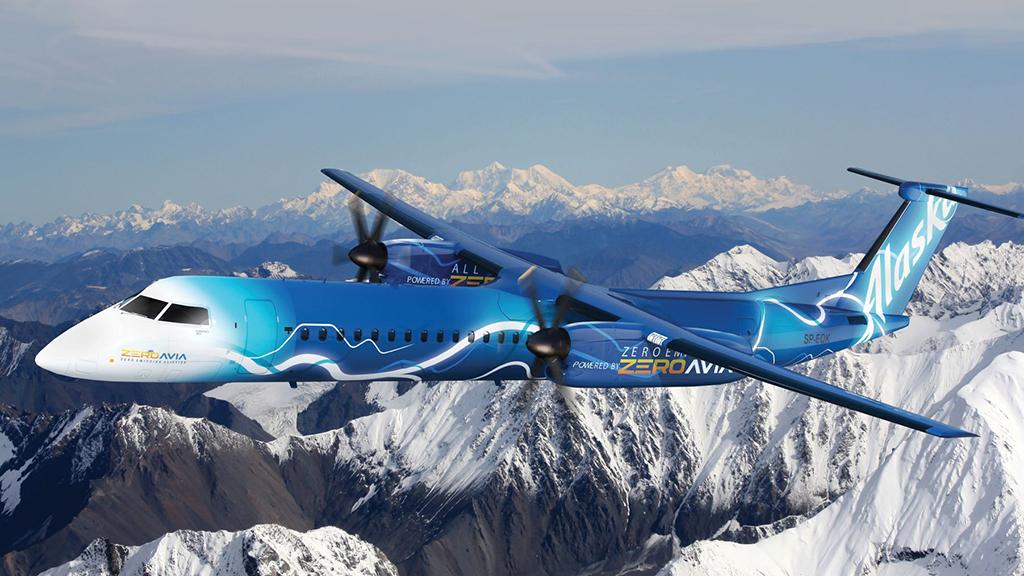Hydrogen-Electric Power Potential Expands to Large Regional Airliners


Proponents of hydrogen-electric propulsion are pushing deeper into short-haul air transportation with deals that could see the conversion of large turboprops and regional jets and the first zero-emissions commercial passenger flights with smaller aircraft as soon as 2024.
Startup ZeroAvia has announced an agreement with Alaska Air Group to develop a hydrogen-electric powertrain for the 76-seat De Havilland Canada Dash 8-400. Another with Mitsubishi Heavy Industries’ RJ Aviation (MHIRJ) division will evaluate conversion of the Bombardier-built CRJ regional jet family.
- Alaska Air invests in ZeroAvia for Dash 8-400
- MHI partners to explore converting CRJs
A third agreement, with Royal Schiphol Group, is planned to lead to zero-emissions commercial flights between Rotterdam The Hague Airport and London with a 19-seat aircraft in 2024. ZeroAvia is already converting a 19-seat Dornier 228 to a hydrogen fuel-cell propulsion testbed at its Kemble, England, base.
ZeroAvia has so far flown only a six-seat Piper Malibu on fuel-cell power, and even then aided by batteries. So scaling up to the output levels required to reengine regional turboprops and jets represents a significant commitment for a startup.
The ZA600 powertrain under development for 19-seaters produces 600 kW using hydrogen fuel cells and pressurized-gas storage and is sized to replace Pratt & Whitney PT6A-class turboprops. Work has also started on the bigger ZA2000, designed to produce 2-5 megawatts using liquid hydrogen. The propulsion system for the Dash 8-400 will produce more than 3 megawatts and provide 500-nm range.
Under a partnership that has been a year in the making with ZeroAvia, “we’re investing in the company by contributing a De Havilland Q400 [Dash 8-400] aircraft as well as our engineering support, our know-how, to create the world’s largest zero-emissions commercial aircraft,” Pasha Saleh, head of corporate development at Alaska Airlines, told an Oct. 26-27 virtual summit organized by ZeroAvia.
“Alaska Airlines has a sister airline called Horizon Air that operates a large fleet of De Havilland Q400s and Embraer jets. And so we believe that, working with ZeroAvia, we can find a way to decarbonize those operations in a reasonable time frame, less than 10 years,” he said. Alaska has secured options for up to 50 kits to begin converting its regional aircraft to hydrogen-electric power, starting with the -400.
MHIRJ, Mitsubishi’s Montreal-headquartered CRJ support division, will work with ZeroAvia to evaluate the feasibility of a retrofit program for the regional jets and provide engineering services in support of Part 33 certification of the propulsion system. “We are working with propulsion innovators to ensure that we are at the forefront of such developments,” says Hiro Yamamoto, MHIRJ president and CEO.
Sweden’s PowerCell is providing the 125-kW fuel cells used in the 600-kW ZA600 system, and ZeroAvia has evaluation orders in place with HyPoint and Hyzon Motors for more power-dense systems for the ZA2000. Hyzon’s Gen3 fuel-cell system for heavy trucks has a stack-level power density of more than 5.5 kW/kg. HyPoint’s turbo air-cooled fuel cell has an energy density of 2 kW/kg at the system level, including the balance of plant, with plans to reach 3 kW/kg.
Rollout of zero-emissions aviation is planned to be supported by a fuel production and dispensing infrastructure being developed by ZeroAvia and its infrastructure partners, which include Shell as an investor and hydrogen supplier. UK startup Octopus Hydrogen is to operate an on-site electrolyzer at Cotswold Airport in Kemble to support flight tests by producing more than 250 kg (550 lb.) of high-pressure green hydrogen a day for ZeroAvia’s mobile refueling unit.
“We believe that in the future almost every aircraft in the world will be powered by hydrogen-electric engines, simply because it is the most viable and scalable method for eliminating carbon and also to cut other harmful emissions from the aviation sector,” says ZeroAvia CEO Val Miftakhov.
In March, British Airways (BA) became an investor in ZeroAvia. This followed a partnership between the startup and Hangar 51, an innovation accelerator program within the airline’s parent company, International Airlines Group (IAG). “It was a 10-week short, sharp project, and we used that as an opportunity to start exploring what is the art of the possible for hydrogen within the IAG network,” Carrie Harris, BA’s head of sustainability, told the summit.
The project highlighted two potential benefits: “There could be lower operating costs, and we think that traveling in zero-emissions flights could really appeal to our customers,” she said. The study indicated a 72-seat hydrogen turboprop could be cost-competitive by 2027 and a 180-seat narrowbody by 2030.
“For us, it was encouraging to see that, if the technology continues to evolve as we hope it will, then by 2050 the majority of our short-haul routes, certainly within Europe, could be operating on hydrogen propulsion,” Harris said.
“We do feel optimistic that, by 2035, we can see single-aisle replacement aircraft that could be using hydrogen propulsion systems,” she said. “Zero-Avia is one important player, but we’re seeing a growing consensus amongst many operators and innovators in this space that the opportunity for hydrogen in aviation is real, and there is consensus around that materializing later this decade and reaching the scale of flights that we’re looking at toward the middle of the 2030s.”






